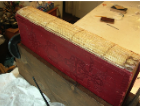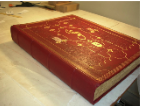Rows of books, a splice of past and future, lie on my workbench for me to take up and sew, to connect the threads that have spiraled between quires in a continuous winding and looping of binder to binder over the centuries. And when we slip our hands around the spines of these old books, into the impressions of thousands of other hands, time's perimeters come down as in dreams, and we hold for a moment a particle of an era, and of a soul. I place the first volume on the bare, white table. Dirt has collected along the edges and blackened the headbands, corners are split and bumped, decades of dust have colored the fore edge gray. Oil and moisture have deepened the calfskin's lustre, while rubbing from use has stripped away the smooth surface on the joints and across the bands exposing a nap of tiny hairs. The endpaper was rapidly pasted down; after I remove it and brush it out with a new paste, it will curl and roll, the moisture like blood come to veins, awakening a dormant spirit, releasing an old memory of limbs and bark and sap. The hide is lined by tracks of veins; the letters on the spine are hand-stamped and crooked, and this slight imperfection seems to be a measure of man's impatience and his imagination. Like petals of a flower the book opens flat and lifts, pages pop lightly, the spine creaks. I put my nose to the paper and breathe in the mustiness of time: old sitting rooms, attics in summer, damp of early October mornings, dry August fields. These simple objects are true fragments of spirit. In pulling the thread through the folds the binder pulls to earth man's visions, beliefs, thoughts, and experiences - ties up, ties together life itself.
-Jennifer T Jestin





